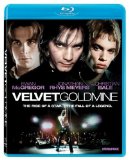| Reviews & Columns |
|
Reviews DVD TV on DVD Blu-ray 4K UHD International DVDs In Theaters Reviews by Studio Video Games Features Collector Series DVDs Easter Egg Database Interviews DVD Talk Radio Feature Articles Columns Anime Talk DVD Savant Horror DVDs The M.O.D. Squad Art House HD Talk Silent DVD
|
DVD Talk Forum |
|
|
| Resources |
|
DVD Price Search Customer Service #'s RCE Info Links |
|
Columns
|
|
|
Velvet Goldmine
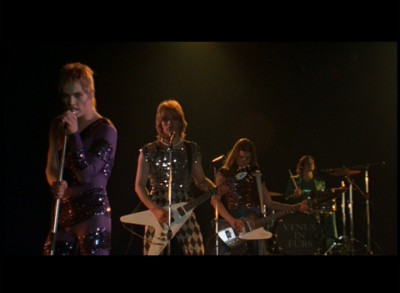
Please Note: The screen captures used here are taken from the 1999 DVD release and reflect neither the corrected aspect ratio nor the improved image quality of the Blu-ray edition under review.
All the excitement leading up to the 1998 release of Velvet Goldmine, Todd Haynes's (I'm Not There) epic meditation on the "glam rock" pop-music movement of the early 1970s, has now, 13 years later, long been forgotten. Widely hyped and discussed as the film was, it received an overall befuddled critical reception, haphazard mishandling and misrepresentation by Miramax, its U.S. distributor, and poor box office. I remember the excited anticipation and the steep post-release drop-off very well; I was growing into my own cinephilia at the time, and it was the first picture by Todd Haynes (whose films, like the life-changing Safe, had made a deep impression on me on video at home) that I saw on the big screen, and I revisited it multiple times during that first run, and then again over the years on DVD. What I saw in 1998, and what remains impressive after all this time, is the kind of thing that, disheartening as the indifference and misunderstanding it met may have been, easily survives the arbitrary vacillations of an inopportune, unwelcoming cultural moment: This is a film whose artistic ambitions and true independence of spirit were never designed to be the kind of crossover Miramax had by then come to demand that each one of its releases be, but it leaves a decidedly stronger impression and is a much more interesting film than Life is Beautiful, Shakespeare in Love, or any of the other, more favored and accessible (and profitable) Miramax projects of the time.
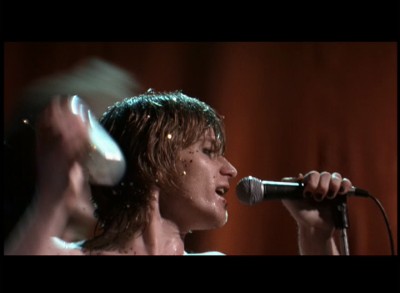
The film differs and distinguishes itself in innumerable ways from Haynes's more recent, more immediately acclaimed I'm Not There, but it's useful enough, as a thumbnail summation, to say that it does with the mythology of David Bowie, Iggy Pop, Lou Reed, and Roxy Music (none of whom are mentioned by name and are represented instead by amalgam/composite fictional characters) what I'm Not There does with that of Dylan, which is to say that it uses the actual lives and work of popular but serious musical artists as a jumping-off point for an investigation whereby complex questions are posed regarding art, identity, culture, and an artist's relationship with--and responsibility (or not) to--their public and the world around them. (Tough but tender, as these are questions that only arise in the first place from having an enthusiastic, appreciative fan's relationship with the music and its makers.) In Velvet Goldmine, the investigation takes on a more direct form than the one conducted by I'm Not There: Its structure riffs on Citizen Kane, with a New York journalist, Arthur Stuart (Christian Bale) going back to untangle the complicated, often illusory story of the glam-rock idols of his English youth, the Brian Slade (the British "Bowie" figure, played by Match Point's Jonathan Rhys-Meyers) and Curt Wild (the American Iggy Pop/Lou Reed figure, embodied by Beginners's Ewan McGregor). The film's "present," when Arthur is chasing his scoop, is doomy Reagan/Thatcher 1984; its past is approximately 10 years earlier, when Slade killed off his massively popular "Maxwell Demon" musical persona (à la Bowie's "Ziggy Stardust") via a shooting hoax that led the world to temporarily believe Slade to have actually been murdered onstage. As in Kane, Arthur's detective work leads to flashbacks that tell the bulk of the film's story, with the exception that his own life, unlike that of Kane's silhouetted, anonymous journalist, is also part of the recollections, and it overlaps in what turn out to be surprisingly extensive ways with those of his rock heroes of yore.
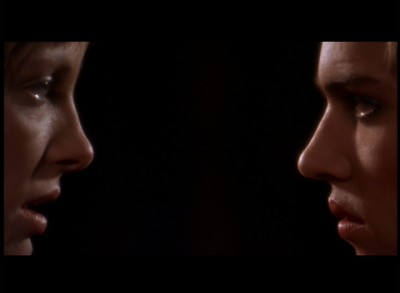
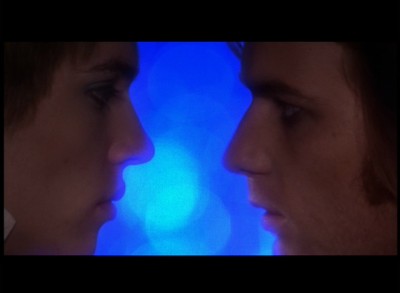
Through these present-day interviews with Slade's former manager (Michael Feast, wheelchair-bound like Joseph Cotten in Kane) and ex-wife, Mandy (Toni Collette, now, like the second Mrs. Kane, a beaten-down, nightclub-dwelling ghost), Stuart fills in the gaps on Slade and Wild that were left by his solitary, obsessive playing of their records and reading up on the media coverage of their escapades when he was an isolated, sexually repressed teenager in dreary suburban Manchester (at that time something like the Detroit or Pittsburgh of England). The interwoven flashbacks of the manager, the ex-wife, and Arthur himself trace the rise and fall of Brian Slade, from his rock-obsessed childhood and youth as a provincial much like Arthur to his involvement with the "dandy" fashion movement/subculture of the late '60s to his meeting and falling in love with Mandy against the backdrop of the Sombrero, a gay nightclub where Slade picks up the pansexual, androgynous style he will later combine as a performer with his folkish, melancholy music, inviting abuse from his unreconstructed hippie audience for wearing a flowing dress and embracing drama and artifice in his torch-like ballads. But it's not until after a) falling in love with the rowdy, electric-guitar influence--not to mention the actual person--of Curt Wild and b) throwing over the kind, softhearted manager whom Stuart later interviews for the aggressively fame-and-fortune-building Jerry Devine (Eddie Izzard) that Slade evolves the harder-edged "Maxwell Demon" persona, setting the world alight with his outrageously coiffed and made-up look and defiant, newly loud music, and scandalizing everyone with proclamations of his and Mandy's open marriage, his bisexuality, and his well-publicized romance with Wild. Scandalizing and liberating: While the drama and conflict of creativity, ambition, commerce, romance, and spiraling excess plays out among the high-profile crowd from which all the lovely sounds and delectable images are emanating, young, ruddy-cheeked Arthur Stuart, mocked for his love of "pansy rockers," is experiencing teen-bedroom libidinous unleashing through its graces, masturbating wide-eyed over a music-press photograph of Slade and Wild locked in an eager open-mouthed kiss. As the meaning of what he's up to begins to escape Slade in a whirl of unbridled, pleasure-seeking rock-star hedonism and claustrophobic paranoia about his fictional persona, its significance becomes direct, clear, intense, and galvanizing for Arthur, whose life has in some significant way been lit up and changed by the music and radical ideas of Slade and his peers. (Among the many provocative questions raised by the film, perhaps the moist poignant is the one having to do with who possesses the privilege of dictating a song's--or book's, or film's--meaning; the mercurial artist who created it, or the consumer who willingly lets it permeate his life, finding in it a reassuring conduit for unexpressed vulnerability and difference.) Memory and investigation come to a head as Stuart unearths the secret of what has become of Slade and Wild, and finds himself possibly on the brink of rediscovering the fire that brought him closer to rock 'n roll's '70s sexual revolution than he ever would have imagined back in his lonely room.
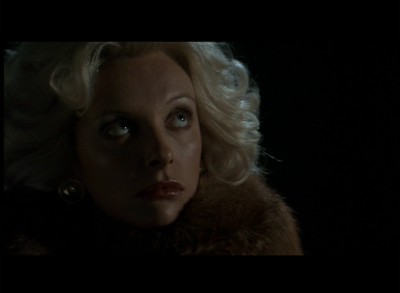
Velvet Goldmine's structure has its distinctions from that of I'm Not There, but one thing Haynes's two musical/pop culture-mythology-themed works decidedly have in common is the collage-like, overwhelming impression left by their overlapping, free-associative fragments of mythicized biography that bleed into and connect with one another at the most surprising, gratifying junctures. Haynes, cinematographer Maryse Alberti (who also shot Haynes's first feature, Poison, Terry Zwigoff's Crumb, and Todd Solondz's Happiness), renowned production designer Christopher Hobbs (who has worked with Derek Jarman and Terence Davies), and costume designer Sandy Powell (who has dressed up every Scorsese film since Gangs of New York) create an amazing pastiche of '70s-film stylings, referencing concert movies; Nic Roeg (Performance, The Man Who Fell to Earth); Robert Altman's hazy, zoom-happy, floating aesthetic; the self-conscious, flamboyant shock value of Bowie's pre-music-video promo clips of the glam period, and countless other bits of imagery, dialogue, history, and hearsay. These, combined with the film's vast, multilayered soundtrack combining music from the era (Brian Eno, Roxy Music, T. Rex, Lou Reed) with specially-made cover versions (the music of the time interpreted by of the actors, Radiohead's Thom Yorke, and UK rock sensation Placebo), and original tunes (by Shudder to Think, with a score by Carter Burwell), create a fever dream of the sort that might be induced by a marathon up-all-night revisiting of earlier Bowie albums aided by this or that illicit substance. Velvet Goldmine is no mindless nostalgia trip, however; the tension provided by Haynes's at once adoring and skeptical treatment of what is clearly a music and pop-cultural moment that means much to him make the film a rich, bracing, even confounding experience with the staying power of a classic--one you can't wait to go back to and get pleasurably discombobulated by once again.
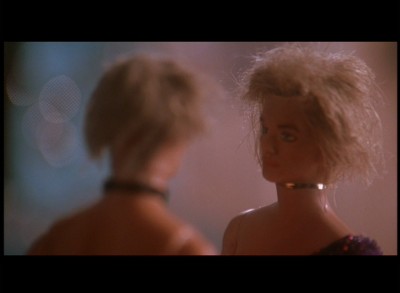
THE BLU-RAY DISC:
The transfer for this Blu-ray release--AVC/MPEG-4, mastered at 1080/24p--is beautiful, absolutely faithful to and respectful of the film's very particular grain(s) and texture(s). The colors--often very bright--pop wonderfully, skin tones are stable and natural-looking, and the visually darker moments are solid, with no noticeable crushing or flicker. In addition, although the film's North American theatrical and DVD releases (again, at the hands of Miramax) were at the 1.85:1 aspect ratio, and this Blu-ray's packaging claims the same, it appears in fact to be presented in the 1.77:1 aspect ratio of its UK/European releases. I'm guessing that this is the more accurate/intentional ratio, as it crops out at least one briefly visible boom mic shadow I had always noticed, and everything else still looks nicely framed and composed.
Sound:The 5.1 DTS-HD Master Audio soundtrack gives the film's very music-heavy sound the room-filling, rich, clear power it needs and deserves. Velvet Goldmine has a complicated and intricate sonic layering to match its visual/narrative structure, and every nuance is discernible here, without a second of distortion or imbalance to be heard anywhere. As with the visual presentation, the markedly improved, truer aural dimension of the Blu-ray release was worth the too-long wait.
Extras:Haynes is master of the insightful, articulate, open, generous, intellectual yet quite down-to-earth audio commentary (this is his only feature film that has not had a commentary to date, and I've listened to and can vouch for all the others, from Poison to I'm Not There); for Velvet Goldmine's commentary, he teams with his long-time producer Christine Vachon to provide a panoply of on-set/production reminiscences and historical/cultural contextualizations. (The commentary was recorded recently, in an act of recovery and restoration after the initial Velvet Goldmine DVD's notorious bare-bones release, which Haynes has long complained that he was never asked to participate in or provide commentary on.) That, in addition to the film's clearly done-by-committee U.S. theatrical trailer are the extent of the extras, but that commentary is a biggie; it's not too much to re-watch the film right away with Haynes and Vachon recollecting and repartee-ing over it.
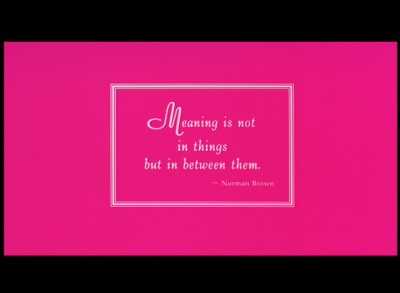
Velvet Goldmine is one of not too many "indie" homages to the artistically emboldened cinema of the '70s to actually attain that elusive, challenging, strange and heady mix of decadence and intelligence with which its models--from Performance to A Clockwork Orange to The Conformist to The Man Who Fell to Earth and countless others--were imbued. It nimbly blurs sexual, biographical, and cultural lines as it admiringly interrogates that long-gestating, explosive, fleeting moment of shocking pop-music smartness and half-ironically-concealed melancholy that was the early-70's glam-rock heyday of Bowie, Iggy Pop, and the mini-galaxy of pop-music stars that surrounded them. It's a film so packed with ideas, wit, and the sheer, juicy passion of its exceptional brand of rock music, it can seem almost overstuffed when one is first exposed to it. But that's okay; the thrills and adventurousness of Todd Haynes's filmmaking bedazzles even as it makes your head spin, and ( particularly now that its look and sound have been so finely emblazoned onto the Blu-ray format) Velvet Goldmine makes for perennially compulsive viewing, always beckoning you back for more and richly rewarding you for the effort. Highly Recommended.
|
| Popular Reviews |
| Sponsored Links |
|
|
| Sponsored Links |
|
|
| Release List | Reviews | Shop | Newsletter | Forum | DVD Giveaways | Blu-Ray | Advertise |
|
Copyright 2024 DVDTalk.com All Rights Reserved. Legal Info, Privacy Policy, Terms of Use,
Manage Preferences,
Your Privacy Choices | |||||||









